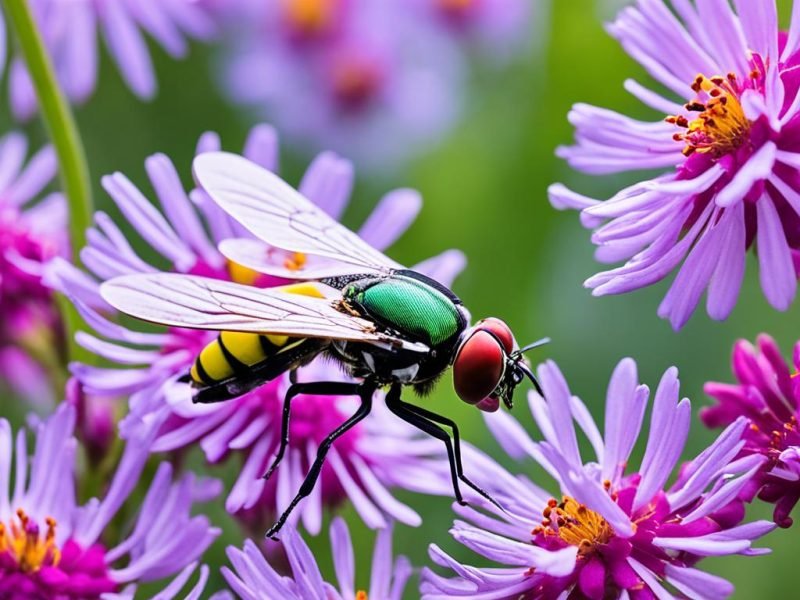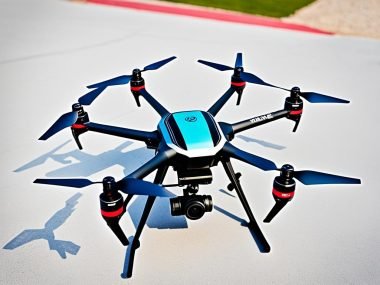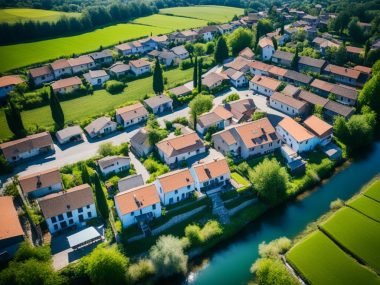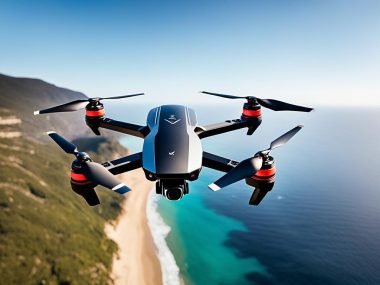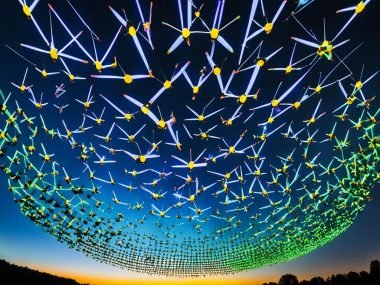At first look, drone flies might just be mistaken for honeybees. But these flies are more than they seem. They play a big part in nature, helping pollinate about 76% of leading food crops. Thus, they are key to our ecosystems. When we ask, ‘Are Drone Flies Good?’ the answer is yes. They not only help with pollination but also in controlling pests naturally. This keeps our ecosystems balanced.
Key Takeaways
- Drone flies, such as Eristalis tenax, are safe for humans and bring many ecological benefits.
- They often get mistaken for honeybees because they look a lot alike.
- Drone flies work all year, even in mild winters, not just during certain seasons.
- They help pollinate many plants, including important fruit trees for farming.
- Besides pollination, drone flies also help control pests in a natural way, showing their wide importance to ecology.
Understanding the Drone Fly: An Overview of Eristalis tenax
In my study of Eristalis tenax, I’ve learned much about these skilled mimics. Knowing how drone fly larvae and adults help the ecosystem is key. Let’s explore the interesting world of this fly.
The Mimicry of Honeybees by Drone Flies
The Eristalis tenax is amazing at looking like honeybees. They use Batesian mimicry, sporting stripes and hairy bodies to avoid predators. This trickery shows how looks can be key for survival among insects. It also makes us think about how to manage drone flies without harming their ecosystem role.
Characteristics and Identification of Drone Flies
Identifying drone fly species focuses on small details. The Eristalis tenax has one pair of wings, unlike bees’ two. They also don’t have the bees’ narrow waist, showing a fuller body shape. Knowing these features helps us recognize drone flies and understand their place in nature. Recognizing this species is crucial for grasping their environmental impact.
Ecological Benefits of Drone Flies
I’ve learned a lot about the hidden heroes of our ecosystems as a writer. The drone flies play a key role in keeping nature balanced. They help with pollination and controlling pests naturally.
Pollination: Drone Flies’ Role in Supporting Plant Life
Drone flies are not only good at looking like other insects, but they also help plants grow. Their bodies pick up pollen easily. This helps our favorite foods like coffee and mangoes grow well. Without them, our food supply could face big problems.
Natural Pest Control: How Drone Fly Larvae Contribute
Allograpta obliqua, a type of drone fly, has larvae that eat harmful aphids. This helps plants by reducing pest damage. It shows how drone flies make farming better without using harmful chemicals.
| Insect Role | Benefit to Ecosystem | Benefit to Agriculture |
|---|---|---|
| Drone Fly Adult | Pollination | Reproduction of crops and flowers |
| Drone Fly Larvae | Aphid predation | Reduction of crop damage |
Drone flies are important parts of our ecosystem, not just simple insects. Their actions support growth and balance in nature. They are crucial for a healthy and green planet.
Are Drone Flies Good? Weighing the Pros and Cons
Exploring drone flies involves looking at both their benefits and drawbacks. They help in natural pest control and sustainable pest management. But, there are worries about their larvae in some cases.
These creatures are key to our ecosystems. They control harmful insects effectively. This role supports sustainable pest management, reducing the need for chemicals in farming.
Drone fly control becomes important near livestock areas. While human myiasis is rare, it’s a concern. Still, the benefits of drone flies outweigh the negatives. They boost biodiversity and help in agriculture.
Drone flies enhance pollination in gardens. This leads to better plant growth and higher yields. Their role in decomposition also balances our ecosystem.
To show the balance, here’s a table of pros and cons:
| Benefits of Drone Flies | Challenges of Drone Flies |
|---|---|
| Pollination of numerous plant species | Potential for larvae to cause myiasis |
| Reduction in harmful pest populations | Can be a nuisance in livestock management |
| Contribution to sustainable pest management | Need for careful drone fly control near human dwellings |
| Assistance in the decomposition of organic matter | Occasional imbalance in local ecosystems |
Considering these factors, drone flies are vital. Our environments would struggle more without them. They’re essential for sustainable pest management. Still, we need proper drone fly control to limit any issues.
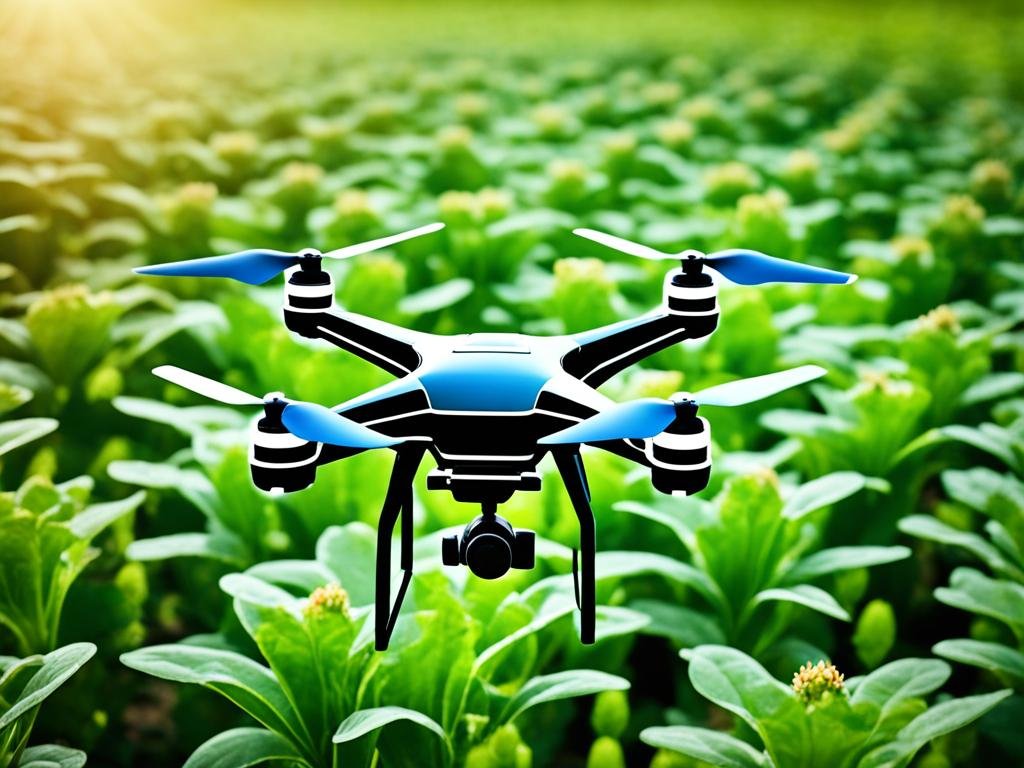
Drone Flies as Pollinators: Their Impact on Agriculture and Gardens
Exploring insect pollination highlights the critical role of drone fly pollinators. They are key in boosting the productivity of agriculture and gardens. These hardworking insects are crucial for the growth and diversity of our plants.
The Pollination of Crucial Crops by Drone Flies
Drone flies masterfully pollinate essential crops by moving from flower to flower. This action is not just for show. It is vital for fruit and vegetable production. In fields and orchards, their presence leads to healthier crops and more harvest. Thus, showing the importance of drone fly pollinators in our food supply.
Seasonal Activity and the Wide Range of Plants Benefited
Drone flies are active from spring to fall, not just in warm months. This ensures ongoing pollination for various plants. They adapt well and pollinate many plant types.
These insects especially like yellow flowers. In fields full of dandelions, drone flies are busy at work. Their efforts support our ecosystems and make our gardens beautiful and useful.
| Crop | Importance of Pollination | Contribution by Drone Flies |
|---|---|---|
| Tonkin Snakewood | Crucial for seed production | Major pollinator, enhancing crop yield |
| Apple | Improves quality and quantity of fruit | Supplements the work of bees in pollination |
| Pumpkin | Essential for fruit set | Active in transferring pollen in larger flowers |
| Sunflower | Required for seed development | Pollinates effectively due to affinity for yellow |
Looking at our harvests shows the agricultural value of drone fly pollinators. Without them, our food would be less abundant and more expensive. These insect pollinators keep our gardens and crops beautiful and fruitful.
Identifying and Encouraging Drone Fly Populations
I am a big supporter of our flying friends and have learned a lot about fly species identification for conservation. Understanding these important pollinators helps us meet their specific needs. This lets them flourish. To help them, we create friendly habitats. These support their life cycle and help maintain a healthy ecosystem.
Creating Drone Fly-Friendly Habitats: Tips and Best Practices
To make a safe place for drone flies, there are several tips anyone can follow:
- Grow nectar-rich flowers like Ivy, Lavender, and Buddleia. These provide food for adult flies.
- Keep natural mulch and leaf litter. This helps make organic compost which feeds larvae.
- Use fewer pesticides to keep these supporting pollinators safe from dangerous chemicals.
These easy steps make our gardens look better and help keep pollinator populations healthy.
Volunteering for Conservation Efforts to Support Fly Species
Aside from working in the garden, volunteering with conservation groups is very rewarding. Helping with habitat restoration, counting species, and teaching others are great ways to make a difference. Here’s how volunteering helps:
| Conservation Activity | Benefits to Drone Flies | Impact on Ecosystem |
|---|---|---|
| Habitat Restoration | Increases foraging and nesting areas | Boosts overall biodiversity |
| Species Monitoring | Helps track population health and growth | Informs conservation strategies |
| Educational Outreach | Raises public awareness and support | Promotes sustainable community practices |
By doing our part in these efforts, we help drone flies and the larger ecosystem they support.
Tackling Misconceptions: Are Drone Flies Harmful?
In my quest to learn about our ecosystem, I’ve found many Misconceptions about drone flies. People often confuse these harmless bugs with dangerous ones because they look similar. But, upon closer inspection, we see drone flies and their larvae use Batesian mimicry. This means they mimic dangerous creatures to avoid predators, but they’re not a threat to us.
Differentiating Between Harmless and Pernicious Fly Species
It’s vital to tell apart different fly species. Unlike harmful flies that can spread diseases, drone flies are safe. They mimic bees and wasps and help the environment. Knowing how to identify these insects can save us from unnecessary fear. It also helps us value their role in nature.
Understanding Batesian Mimicry: Evolutionary Advantage Without Harm
Batesian mimicry is a cool concept. A harmless species imitates a dangerous one’s warning signs. Drone flies have mastered this trick. They look like they could sting, but they don’t. They’re actually good for our ecosystems. Their larvae help break down dead stuff, not cause problems.
Not knowing the truth about these benign insects can lead to needless fear. This fear might cause us to try to get rid of these important pollinators. Learning and sharing facts about drone flies helps us understand. It also makes us appreciate the diversity of life around us.
Conclusion
“Are Drone Flies Good?” is a question I’ve thought a lot about. I’ve learned they are very important to nature. They do more than just look like they are copycats; they help our ecosystems stay healthy. They help with pollinating plants and controlling pests.
Drone flies make a big difference by helping plants grow. This helps with the variety of life and keeps our food supply strong. This is crucial for feeding people and keeping nature diverse.
The benefits of drone flies can’t be ignored. They help keep the number of harmful insects down. This makes farming more natural and better for the earth. As someone who writes about nature’s wonders, I say we need to protect these amazing insects. We should make sure they have what they need to live and grow.
We should educate people on how important drone flies are. By living in harmony with them, we can have a healthier planet. They might be small, but their effect is huge. They help make our world a better, more balanced place for all living things. So, yes, drone flies are definitely good for our planet.

